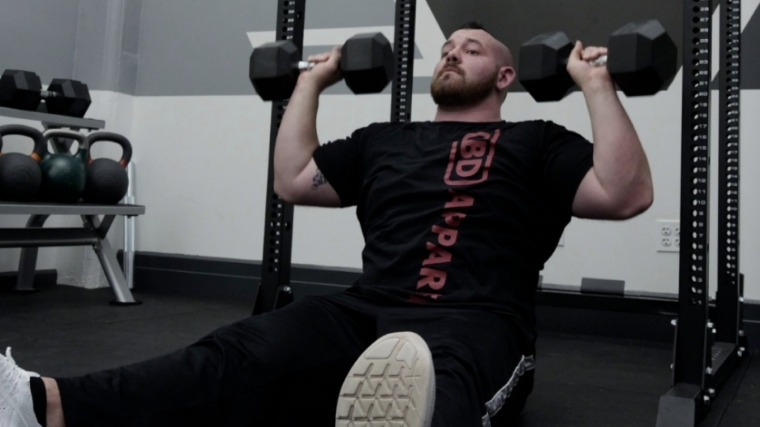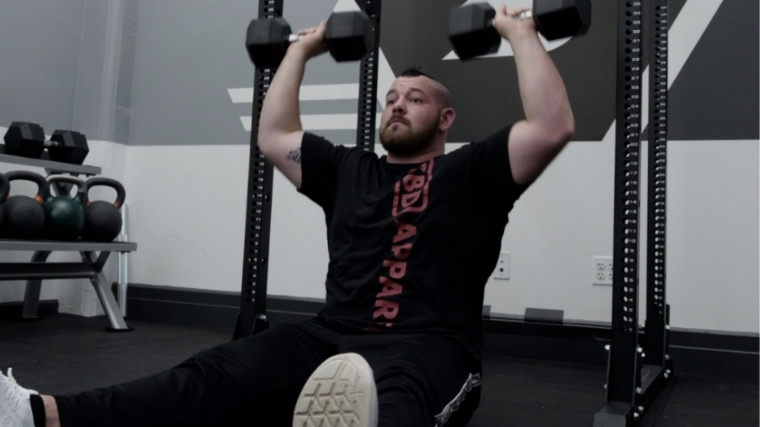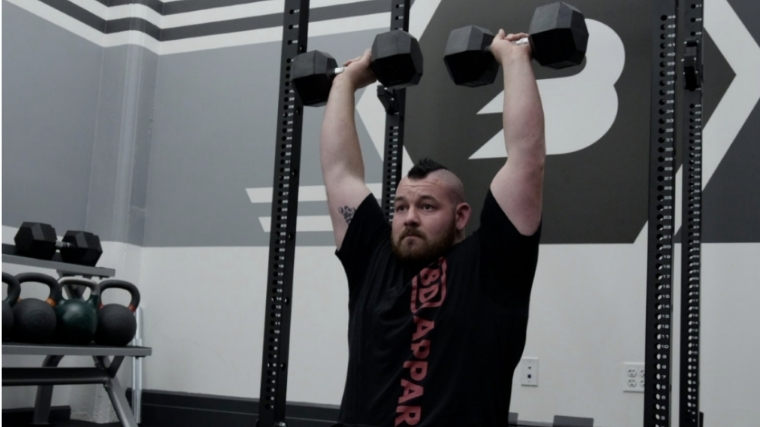This article will explore one of the most functional (and challenging) overhead pressing movements. Whether you decide to use a barbell, kettlebells, or dumbbells, the Z press will surely help you gain upper body strength, stronger abs, and better overhead pressing mechanics.
The Z press can build strength, improve posture, and enhance pressing stability and performance in sports like weightlifting, powerlifting, and strongman. Additionally, it is a great exercise to reinforce proper scapular control and tension to aid in injury prevention of the shoulders during most pressing movements.
- How to Do the Z Press
- Z Press Sets and Reps
- Common Z Press Mistakes
- Z Press Variations
- Z Press Alternatives
- Muscles Worked by the Z Press
- Benefits of the Z Press
- Who Should Do the Z Press
- Frequently Asked Questions
Editor’s note: The content on BarBend is meant to be informative in nature, but it shouldn’t take the place of advice and/or supervision from a medical professional. The opinions and articles on this site are not intended for use as diagnosis, prevention, and/or treatment of health problems. Speak with your physician if you have any concerns.
Z Press Video Guide
Check out our video tutorial below for more in-depth Z press tips. Pro strongman and one of the strongest pressers ever, Rob Kearney, walks you through it.
How to Do the Z Press
Here’s an in-depth, step-by-step breakdown of how to do the Z press optimally.
Step 1 — Set a Strong Base
First, create a strong base to press from on the floor by sitting with straight legs, an upright torso, and heels grounded/dug into the floor. Similar to the overhead press, your upper back should be tight with the lats creating a strong shelf to press from. The core and hip musculature should be engaged, as the spine should remain as rigid as possible when loaded. The Z Press starting position can be performed in a power rack with a barbell or flat ground with dumbbells or kettlebells.
Form Tip: Spend 5-10 extra minutes stretching and opening the hip before performing the Z press, even if you already feel warmed-up. Sitting down with your legs extended will challenge your hip and hamstring mobility.
Step 2 — Brace Downwards and Press Up
Similar to any overhead press, the Z press will require your upper back to be fully engaged when pressing while keeping the implement close to the body. Your elbows should remain under your wrists in the press, and when locking out, the arms should be fully extended, with the head coming through the “hole” at the top.
To start the press, think about compressing your ribcage downwards to activate your obliques and abdominals. As you do this, you should then try to press upwards through the weights, not allowing your ribcage to expand or flare outwards.
Your body will more than likely want to press with the weight slightly in front of it to build better balance. Resist this by maintaining core tightness.
Form Tip: If you’re falling forwards or backward during the Z press, then your bar path may be wonky. For those experiencing this, try using dumbbells and working mobility longer in warm-ups.
Step 3 — Lockout and Descend
Once you’ve locked out the weight overhead, you’ll bring down the press with control, so the core remains upright through the whole range of motion. If you find that you’re wavering and losing balance during the descent, then try to slow your tempo, as this can help clean up the bar path.
Form Tip: Pay close attention to the body and try to feel working hardest to stabilize your body. For example, if your hips are aching or tightening, then more than likely, this is an area that requires a little extra work.
Z Press Sets and Reps
This might not be the primary lift you choose for building absolute strength overhead. But even if it’s not your main lift, you can still use it to get plenty strong. Here’s how to figure out your Z press set and rep scheme.
- For Technique: As part of your warm-up, do two to three sets of five to 10 reps with a light to moderate load, working on control and movement coordination.
- For Muscle Mass: Try four to six sets of six to 12 repetitions, resting 60 to 90 seconds between heavy to moderate loads.
- For Strength: Perform four to six sets of three to six repetitions, resting two to three minutes between sets.
When you’re performing this move, make sure you’re moving up responsibly. Master the technique with light weights first, and let your know-how shape your goals accordingly.
Common Z Press Mistakes
Any kind of seated press variation might seem easier than standing versions at first blush. But especially when you take away back support, these moves can get complicated really quickly. Here’s what mistakes to look out for with the Z press.
Leaning Too Far Back
If you start lifting before you establish a firm base and steady posture, you’re likely going to lean way back during your press. A little bit of a backward lean is to be expected — think about engaging your lower and middle core by shifting back very slightly.
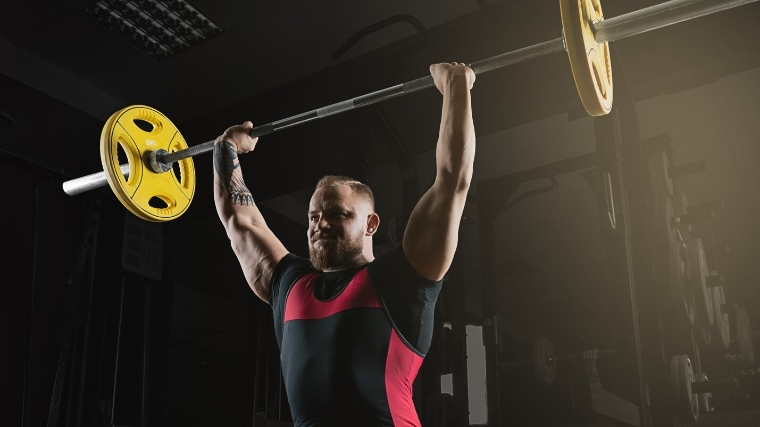
But if your torso drifts further back while you’re pressing in order to kip the weights up, you’re taking your shoulders out of the movement. You also might be risking putting your low back at risk of unintended hyperextension. Once you find a firm base to lift from, focus on pressing right up from there without shifting your torso angle. Bear down into your core, your glutes, and your feet so that you’re pressing your lower body into the ground.
Flaring Your Rib Cage
Even if your entire torso angle isn’t thrown off, you can still flare your ribcage by jutting your chest too much toward the ceiling. You may find yourself doing this to compensate if the weight is too heavy. The important thing here is never to lose tension in your core.
Really focus on keeping your ribcage tucked in and down to allow for maximal assistance from your obliques and rectus abdominis for added structural stability. Once again, focus in on pressing your feet and hips firmly into the ground here.
Not Engaging Your Core
You’ll know if you’re not engaging your core hard enough from cues through the top or bottom of your body. It might be that you’re leaning back too far. Conversely, you may be having a hard time keeping your feet on the ground. If your feet keep popping up between reps, it often means that you’re insufficiently engaging your core.
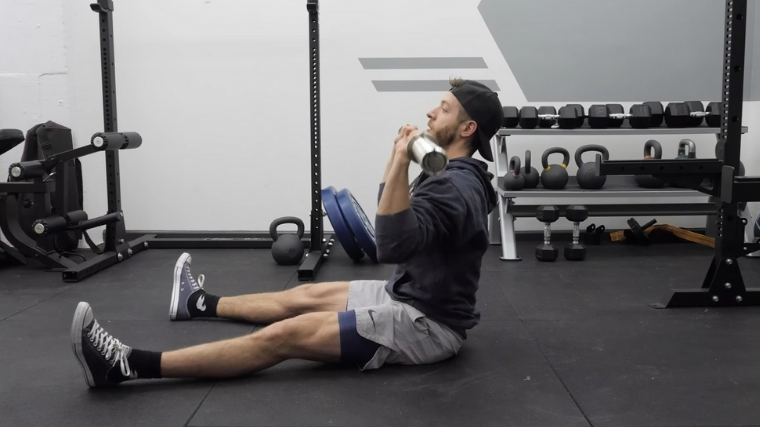
In turn, you aren’t able to maintain that full-body stability. In addition to focusing on pressing your legs and heels down into the ground, concentrate on locking down your core before, during, and after each rep.
Z Press Variations
The below Z press variations can elicit a different feel for a lifter and also offer up a much-needed change in programming from time to time.
Barbell Landmine Press
The barbell landmine press is done with a lifter using a barbell (either loaded or unloaded) as the resistance.
This can be a good starter movement, as it does not require as much individual coordination of your hands. Even if you perform this move seated, the anchoring of the barbell on one side will keep you much more balanced overall.
Barbell Overhead Press
The barbell overhead press trains the same movement pattern and muscle groups as the Z press.
This move is many lifters’ go-to when it comes to building a base of overhead strength and prowess. You’ll be standing, but the increased weight you can use means you’ll be firing up your core in a big way.
Kettlebell Z Press
Kettlebells dangle lower than dumbbells when you hold them. This off-centered load creates an added stability challenge.
These off-balanced implements give your stabilizer muscles a run for their money and up the ante of many lifts — the Z press included.
Unilateral Z Press
Also known as a single-arm Z press, this variation allows one side of the body to catch up to the other if it’s weaker.
You’ll need to use a kettlebell or a dumbbell for this press. These implements will help you fight off any strength or muscle imbalances between sides.
Z Press Alternatives
Below are five common Z press alternatives that can be done to vary programming up, challenge lifters, and more.
Barbell Sots Press
The barbell Sots press is similar to that of the Z press. However, the lifter performs a strict overhead press while at the bottom of the front squat.
This is a great movement to reinforce stability in the bottom of the squat while simultaneously promoting proper overhead mechanics and postural strength.
Single-Arm Kettlebell Sots Press
This is a unilateral variation of the sots press, which is performed with a kettlebell.
Performing the Sots press with a kettlebell increases your core’s lateral stability, increase overhead stability, and help lifters who may struggle to place both hands overhead at once in the standard sots press.
Double Front Rack Kettlebell Carry
The double front rack kettlebell carry is a loaded carry movement that can increase the isometric strength and control of the scapular stabilizers, lats, and core.
https://youtube.com/watch?v=gnzAuA2BipM
While this exercise entails no overhead pressing movements, it helps lifters promote the Z press’s same postural benefits.
Muscles Worked by the Z Press
The Z Press targets many muscles within the upper body and core. By forcing you to be seated in an upright position, without using your legs for added stability and base of support, you force your upper body muscles to work far harder. These are the major moves of the Z press.
Shoulders (Deltoids)
The shoulders, primarily the anterior (front) head of the deltoid, are responsible for most of the force to press the loads overhead. While the triceps and upper pecs do assist in this movement, the shoulders are the prime mover.
Scapular Stabilizers
The scapular stabilizers and muscles that help to promote thoracic extension are called upon to support the integrity of the spine while Z pressing, as well as help stabilize the weight as it is held overhead.
Latissimus Dorsi
The lat muscles are used isometrically to help maintain an upright posture and the stability necessary to press and support loads overhead.
[Read More: The Best Leg Exercises for Your Next Leg Day]
Additionally, they help aid in lowering the load back down to the body.
Obliques and Abdominals
The obliques and rectus abdominis work to anteriorly compress the ribcage during all phases of the Z press. This is key to help stabilize the spine and promote core stability for nearly every movement overhead (as well as most types of squats and pulls).
Erectors Spinae (Lower Back)
The erector spinae contract to maintain the lower back’s rigidity during the pressing and overhead aspect of this movement.
Benefits of the Z Press
Below are four benefits of the Z press. It is important to note that depending on the variation selected (see below), some of the below benefits may be more drastic than using another variation.
Increased Upper Body Strength and Size
Press more weight more often, and any pressing variation will improve your pressing strength. However, the Z press takes your legs out of the equation, so your shoulders are doing almost all of the work. You’ll also better isolate your deltoids, which can help pack on mass to the area.
[Read More: The Best Shoulder Exercises for Bigger, Stronger Shoulders]
Improved Scapular Stability
Pressing any implement from a seated position is going to create an extra layer of instability. As a result, your scapula, which helps stabilize the shoulder, will have to work harder. More stable scaps, however, will carry over to any other press you perform.
More Core Strength and Control
The core is a foundational muscle group that allows the lifter to press the weight. A strong core bridges your upper and lower body and helps you stabilize. When doing the Z press, the lifter cannot use any additional force and stability from the legs and hips.
It’s also harder to compensate for weakness with poor form, which isn’t good but something that does happen. The Z press removes all aids from your overhead press, which will only make you stronger and better able to control the weight you’re moving.
Better Overhead Pressing Performance
The Z press leaves very little margin for error when taking a load from the chest to the overhead position. By performing Z presses, the lifter cannot excessively lean backward, fall forward onto their toes, or use any leg and hip dip to help gain momentum.
This will force the lifter to use upper back and upper trap strength to take the barbell in the exact plane it needs to travel. It is important to note that this is extremely challenging. Be sure to continually practice the press, maintaining smooth and full control at the tip of the lift, and stay as upright as possible.
Who Should Do the Z Press
This movement is great for building shoulder and core strength, packing on shoulder mass, and improving the hips’ mobility and strength. Below, we’ve included three types of athletes who can benefit from the Z Press for specific reasons.
Strength and Power Athletes
Strength athletes like powerlifters, strongman competitors, and weightlifters can all benefit by performing the Z Press. All of these athletes can gain shoulder and core strength and hypertrophy with the Z Press, which is key for success in each of their respective sports. Here’s more specific information for how the Z press can help certain strength athletes.
- Powerlifters: The Z press is great for improving hip mobility, which can be an issue for many athletes during heavy squats.
- Strongmen and Strongwomen: This is an awesome variation to train the shoulders/core without causing an accumulation of fatigue in a program that is probably already heavy with log, strict, and other big pressing variations.
- Weightlifters: Fantastic movement for improving hip mobility/strength and increasing the ability to maintain an upright torso with a strong core, which is a fundamental aspect of the snatch and clean & jerk.
Functional Fitness Athletes
Functional fitness athletes, such as CrossFitters, are often faced with multifaceted workouts. The Z press is a multifaceted exercise that can tick many boxes often needed in these workouts. The Z press improves strength and hypertrophy in the upper body. Still, it’s also great to use for improving muscular endurance capacity, which is a vital characteristic of successful functional fitness athletes.
General Population
The Z press can be useful for the general population and recreational lifters for two major reasons. First, it can help teach correct pressing mechanics, as the form must perform this movement. Therefore, it’s great for beginners trying to learn and feel what it feels like to have proper pressing form. Second, it can help build a strong foundation of core strength and hip mobility, which are two keys that can translate to longevity in the gym.
Press from A to Z
Your biggest strength gains don’t always happen while you’re sitting down — but the Z press is a different story. You’ll abandon the bench, opt for the floor, and in doing so, skyrocket your overhead strength, mobility, and stability. The unique positioning of the Z press offers you increases mobility and stability at the same time. From a tall, unsupported seat, you’ll teach yourself to press with confidence, strength, and a whole lot of mobility. The Z press may not already be part of your repertoire, but that’s no reason you can’t start.
FAQs
Figuring out how to add a new lift to your routine can be tricky. But there are no tricks about how epic the Z press is. Check out these frequently asked Z press questions to lock it down.
Who invented the Z Press?
The exercise was invented by Strongman Zydrunas Savickas (Big Z), hence the name Z press (also called the Savickas press by some).
What types of equipment can you do a Z press with?
Traditionally, the Z press is performed with a barbell. However, you can train the Z press movement using a wide variety of equipment like kettlebells, dumbbells, and even sandbags.
Is the Z press safe for individuals with bad shoulders?
If you have pain or are unsure of whether a move is safe for you, consulting a doctor before hefting weights is generally your best bet. However, if you’re medically cleared to press overhead, the Z press may be able to help you strengthen your upper back and learn to promote overhead strength without sacrificing the stability of your core and upper back.
Featured Image: BarBend
